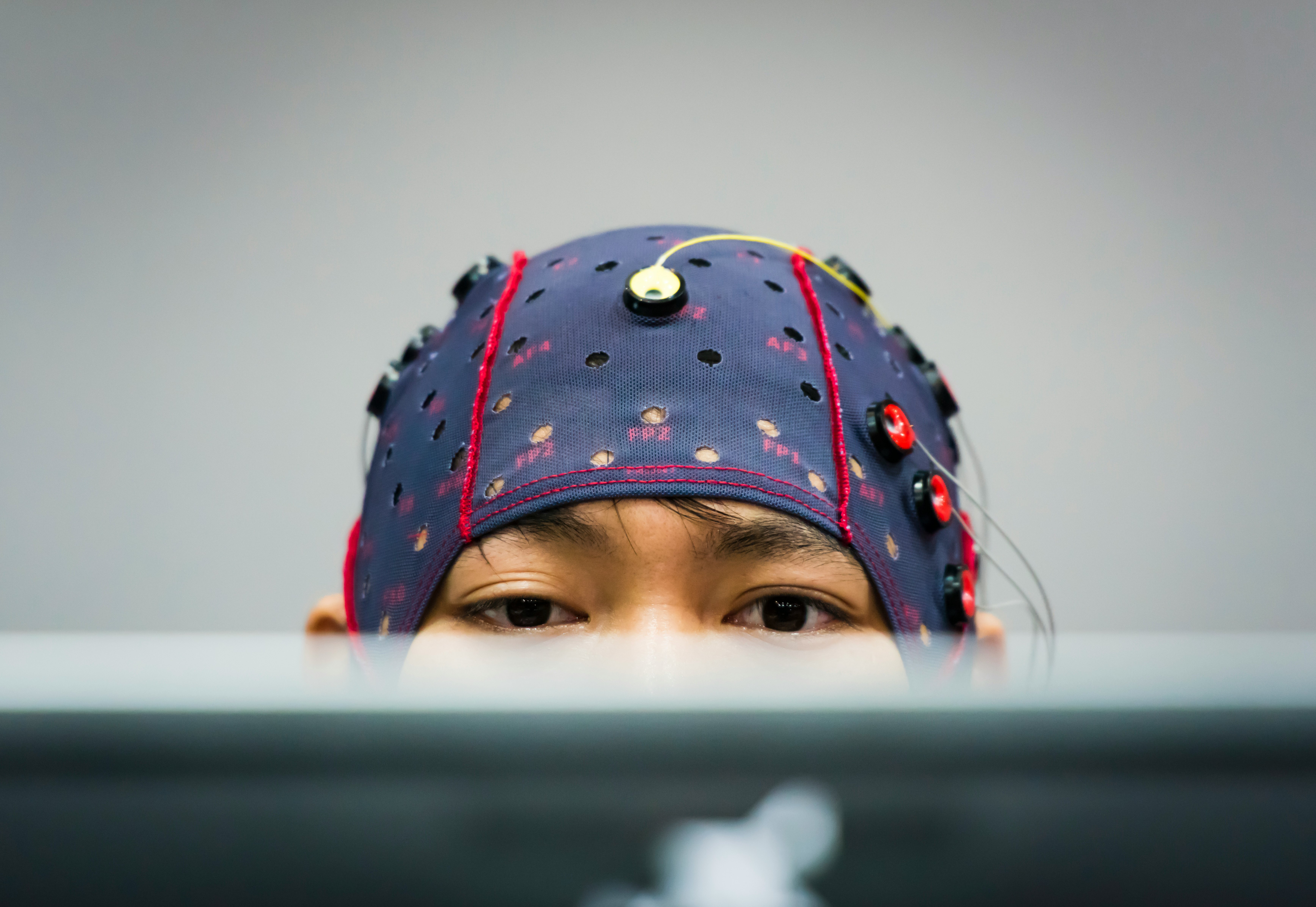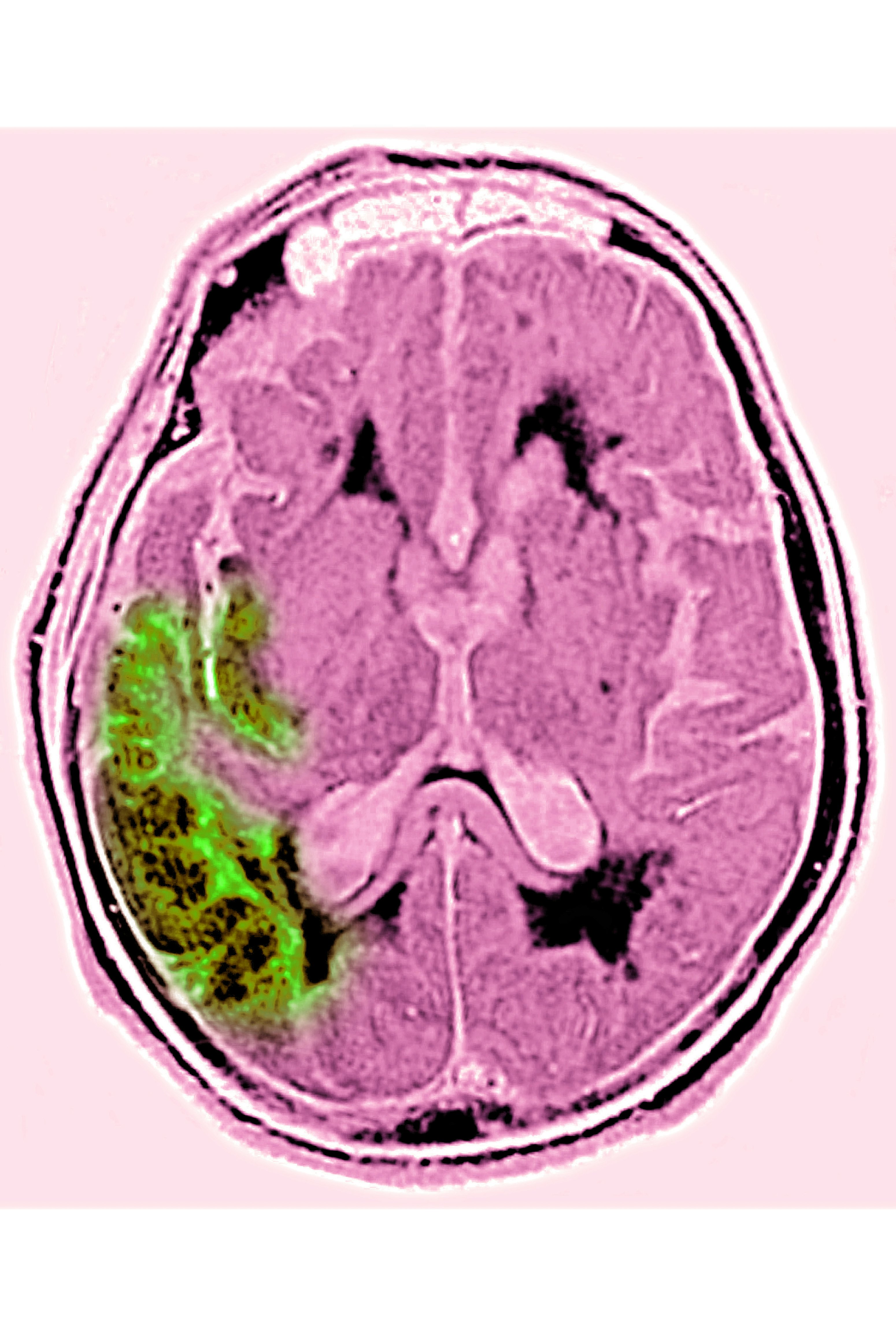
In 1993, Julio Lopes was sipping a coffee at a bar when he had a stroke. He fell into a coma, and two months later, when he regained consciousness, his body was fully paralyzed.
Doctors said the young man’s future was bleak: Save for his eyes, he would never be able to move again. Lopes would have to live with locked-in syndrome (LIS), a rare condition characterized by near-total paralysis of the body and a lucid mind. LIS is predominantly caused by strokes in specific brain regions; it can also be caused by traumatic brain injury, tumors, and progressive diseases like amyotrophic lateral sclerosis, or ALS.
Yet almost 30 years later, Lopes now lives in a small Paris apartment near the Seine. He goes to the theater, watches movies at the cinema, and roams the local park in his wheelchair, accompanied by a caregiver. A small piece of black, red, and green fabric with the word “Portugal” dangles from his wheelchair. On a warm afternoon this past June, his birth country was slated to play against Spain in a soccer match, and he was excited.
“Even if it’s hard at the beginning, you acquire a kind of philosophy of life.”
In an interview at his home, Lopes communicated through a specialized computer camera that tracks a sensor on the lens of his glasses. He made slight movements with his head, selecting letters on a virtual keyboard that appeared on the computer’s screen.
“Even if it’s hard at the beginning, you acquire a kind of philosophy of life,” he said in French. People in his condition may enjoy things others find insignificant, he suggested, and they often develop a capacity to see the bigger picture. That’s not to say daily living is always easy, Lopes added, but overall, he’s happier than he ever thought was possible in his situation.
Defying stereotypes
While research into LIS patients’ quality of life is limited, the data that has been gathered paints a picture that is often at odds with popular presumptions. To be sure, well-being evaluations suggest that up to a third of LIS patients report being severely unhappy. For them, loss of mobility and speech make life truly miserable — and family members and caregivers, as well as the broader public, tend to identify with this perspective. And yet, the majority of LIS patients, the data suggest, are much more like Lopes: They report being relatively happy and that they want very much to live. Indeed, in surveys of well-being, most people with LIS score as high as those without it, suggesting that many people underestimate locked-in patients’ quality of life while overestimating their rates of depression. And this mismatch has implications for clinical care, say brain scientists who study wellbeing in LIS patients.
Eleven U.S. states and several European countries, for example, have legalized various forms of assisted dying, also known as physician-assisted suicide or medical aid in dying. In these places, families and clinicians are often involved in fraught decisions about whether to actively end a person’s life or pursue life-extending interventions such as mechanical ventilation. Advocates for the right to die, a movement that dates back to the 1970s, have historically raised concerns about the potentially dehumanizing nature of these interventions, which can lengthen a person’s life without improving quality. They specifically argue that LIS patients should be able to decide whether to end their lives or stop life-extending treatment.
“It’s important to not project our thoughts and feelings.”
Brain scientists do not disagree, but they worry that inaccurate and negatively skewed ideas about what it means to live with LIS could unduly tip the scales.
“It’s important to not project our thoughts and feelings” onto others, said Steven Laureys, a neurologist and research director of the Belgian National Fund for Scientific Research. While nondisabled individuals might say, “this is not a life worth living,” he added, the evidence doesn’t necessarily bear this out.
He and his colleagues want to ensure that their research is shared with LIS patients, their families, and physicians. The researchers are also trying to better understand which factors contribute to a patient’s overall sense of satisfaction.
Because LIS syndrome is rare, surveys of patients tend to be small, making it difficult to draw firm conclusions. Still, most studies point in the same direction: Most locked-in patients are relatively happy.
One early study, published in 2002, found that of 44 LIS patients, almost half reported their mood as good, while 13 percent reported feeling depressed. A later study, published by Laureys and his colleagues in 2011, found that of 65 patients, just over two-thirds considered themselves happy, while less than one-third said they were unhappy. Seven percent of all patients expressed a wish for assisted dying.
Laureys’ findings should be interpreted with some caution, said Fernando Vidal, a historian and medical anthropologist at the University of Rovira i Virgili in Spain, who was not involved in the study. Almost half of the patients the scientists first reached out to did not respond to the survey, he pointed out — meaning the researchers may have inadvertently selected a sub-group of happy patients. He added that well-being surveys, in general, tend to overlook important nuances about how LIS patients experience life, including their moods, values, and social relationships.
Still, similar results were found for people in advanced stages of ALS. In one study of 93 patients, the majority had a positive attitude toward life-sustaining treatments and had a low desire for hastening death.
Difficult data

Researchers are currently trying to learn if these findings extend to patients with even more extreme physical impairments. In the late stages of ALS, some patients become totally paralyzed, including their eyes — a condition known as completely locked-in syndrome. In March, Nature Communications published the results of a widely-discussed study in which a completely locked-in patient could communicate at length for the first time by using a brain-computer interface.
Brain-computer interfaces are controversial, raising safety and bioethical concerns. And Niels Birbaumer, the neuroscientist who led the March study, has previously been accused of scientific misconduct, along with his research associate, Ujwal Chaudhary. In 2019, the German Research Foundation found evidence of mishandled data and flawed analysis in two of their papers testing brain-computer interfaces in LIS patients. Both papers were subsequently retracted, and the researchers were asked to repay their grant funding. The researchers continue to defend their past work, and more than 70 scientists have expressed their support on a website devoted to their defense.
A representative from Nature Communications has voiced confidence in the journal’s vetting of the March paper. In this latest study, the patient wanted to listen to his favorite music, eat curry, and watch movies with his child. These are clear signs that the study participant is motivated, interested, and still able to enjoy his life, said Birbaumer.
Birbaumer also shared a video with Undark of the patient answering yes-no questions to a well-being survey. In the video, he expresses appreciating his life, rarely being sad or depressed, and living with a sense of meaning. (To protect the study participant’s privacy, the video is unpublished.) “He had an excellent quality of life,” Birbaumer wrote in an email. But only a few patients who are completely locked in have received brain-computer interfaces, added Birbaumer, so it’s impossible to draw firm conclusions about the entire population’s well-being.
It’s also not clear how well these patients will do over time. In the three years since the implants were placed in the study participant’s brain, his communication has become slower and less clear — an outcome that his current physician suspects are due to technological issues.
Time marches on

Despite the evidence that happiness and fulfillment are possible for locked-in people, notions about what is necessary for a good life has been slow to change, even among patients’ family members and caregivers.
One study led by Dorothée Lulé, a professor of experimental neurology at the University of Ulm, Germany, recruited 89 ALS patients, 86 caregivers, and 102 healthy individuals. (Like other researchers, the authors use the term “healthy” to refer to people not living with ALS.) The patients were asked to rate their own quality of life, the caregivers were asked to rate the quality of life of the patient under their care, and the healthy people were asked to rate the quality of life of a virtual patient.
As a group, the patients reported a satisfactory sense of well-being with a low wish to hasten their own deaths. The caregivers and healthy people, on the other hand, overestimated how depressed ALS patients were and underestimated ALS patients’ quality of life.
“Life is a connection between mind and body.”
In a study of more than 3,000 healthy people, more than half said they would not want to be kept alive with locked-in syndrome.
Marie-Christine Nizzi, a research associate in cognitive science at Dartmouth College, characterized the dominant perspective as “an able-bodied biased view by which it seems that such a life is unbearable and must be awful.”
“Don’t let the healthy judge on the sick people’s well-being,” said Albert Ludolph, professor of neurology at the University of Ulm, in Germany. Those without LIS may misunderstand what it’s like to live with the condition.
Still, it’s important to acknowledge that many locked-in patients suffer immensely, said Jan Bernheim, professor emeritus of medicine and medical ethics at the Vrije University Brussels in Belgium.
“Life is a connection between mind and body. It’s therefore also sensory, pleasure, relation with others,” Denis Labayle, co-president of Le Choix, a right-to-die association in France, wrote via email. “Being a prisoner of your own body, for me, is not life.”
In intensive care settings, some patients suffer significant brain damage and are in serious pain. Their wish to die needs to be carefully evaluated and respected, said Laureys. One small study showed that up to 75 percent of patients with LIS die soon after injury. Many of the deaths that Laureys sees in the ICU are due to doctors choosing not to intervene.
Allowing suffering patients to die is “part of our job,” said Laureys. “But I think we need to be extremely careful, and we can err on both sides.”
If patients are to make informed decisions, they need accurate information, including the data showing that those with LIS may go on to have meaningful lives. The researchers who spoke with Undark expressed concern that this might not be happening.
Consider the decision about whether to move onto a mechanical ventilator when one’s lungs begin to fail, said Birbaumer. Some studies of LIS patients suggest that an individual’s quality of life remains intact on a ventilator and that many people could live decades longer. Yet in the vast majority of cases, these patients refuse the intervention.
It’s not clear why so many patients refuse, but culture, politics, and economics probably all play important roles, said Vidal. In Japan, where a strong culture to support the elderly and disabled prevails, LIS patients are more likely to accept ventilators and live longer (about 30 percent of Japanese ALS patients receive mechanical ventilation). Some patients, Vidal said, even reject the notion of being in a locked-in state altogether. In countries where the costs of care aren’t covered and long-term care isn’t available, LIS patients may be less encouraged to go on ventilators and may feel like a burden to their families.
Caregivers and physicians are in a position where they can readily influence decision-making. Their perceptions about LIS patients’ quality of life could be a factor in the lack of desire for ventilators, said Vidal. But he suspects that formally researching this would be tricky. If doctors “would prefer to disconnect people — let’s put it that way — then they might be reluctant to communicate that,” he said.
In addition to accurate information, patients also need time, said Laureys. When patients are first diagnosed, they may experience “reactive depression.” This isn’t the optimal moment for making key decisions about prolonging or shortening life. Instead, Birbaumer suggests, decisions should be delayed until after patients stabilize and adjust to their new situation. Patients should also be asked multiple times over the course of several months to make sure they don’t change their minds.
The difficulty in all of this, said Laureys, is being able to totally respect a patient’s wish to die or withhold treatment while simultaneously making them aware that things may get better in the future. He, therefore, sees it as a balance between respecting a person’s wish to die and a person’s wish to live.
A good life

LIS researchers have been working to better understand the factors that allow locked-in patients to live fulfilling life. Among the strongest predictors of good well-being scores is perceived social support: Patients who feel cared for — regardless of how much support they actually receive — will do better than ones who don’t, said Andrea Kübler, a professor of psychology at the University of Würzburg in Germany. Patients also do well when they place a higher value on their internal life, rather than on their physical capacities. Coping methods like confronting difficulties head-on also seem to be important.
Access to technologies helps, too. Patients who can communicate with others — whether via eye-tracking technologies, tablets, smartphones, or brain-computer interfaces — tend to experience a higher quality of life, said Frédéric Pellas, a physician with the French Association for Locked-in Syndrome in Paris.
Lopes, the LIS patient living in Paris, initially wore a helmet with a stick that he maneuvered with subtle head motions to select letters on a keyboard. The technology proved incredibly slow, taking him one hour to write two phrases. Now, with the camera and sensor, Lopes can write relatively quickly and uses this to communicate with his caregivers, navigate the Internet, and respond to emails. He has also written a book about his journey following his stroke.
Patients with strong family ties, financial support, and caregivers to attend to their needs are more likely to have satisfactory lives than ones who don’t.
With so much innovation in the technology sector, particularly with brain-computer interfaces, access to new devices will be a turning point in boosting the quality of life of these patients, said Laureys: “With these new technologies, even if they can just move a finger if they can control their wheelchair with that finger, go on the Internet — that opens a window.”
But a lot of what determines wellbeing in LIS actually boils down to social and economic forces: Patients with strong family ties, financial support, and caregivers to attend to their needs are more likely to have satisfactory lives than ones who don’t. This is another limitation of some of the studies conducted so far: Patients tend to come from LIS associations, where they have a high quality of care. But not all LIS patients — especially in poorer, resource-starved countries — have or can afford the same kind of treatment, says Birbaumer, so the results aren’t necessarily generalizable to the broader community.
In Lopes’ case, his 24/7 hour care, access to technology, and government financial support all mean that, despite setbacks, he has lived a happy life since his stroke. Finished with typing, he produces a moan directed across the living room, alerting his caregiver that he wants to speak with her. After a brief exchange, she comes out and brings him an orange soda beverage, which she thickens with powder into a foamy juice to make it easier for him to consume. As he swallows, his eyes grow wide, and a hint of a smile appears on his face.
This article was originally published on Undark by Jonathan Moens. Read the original article here.







